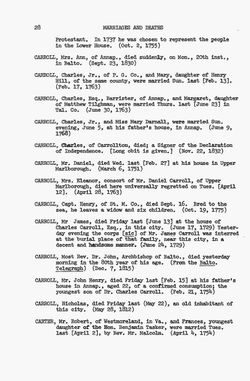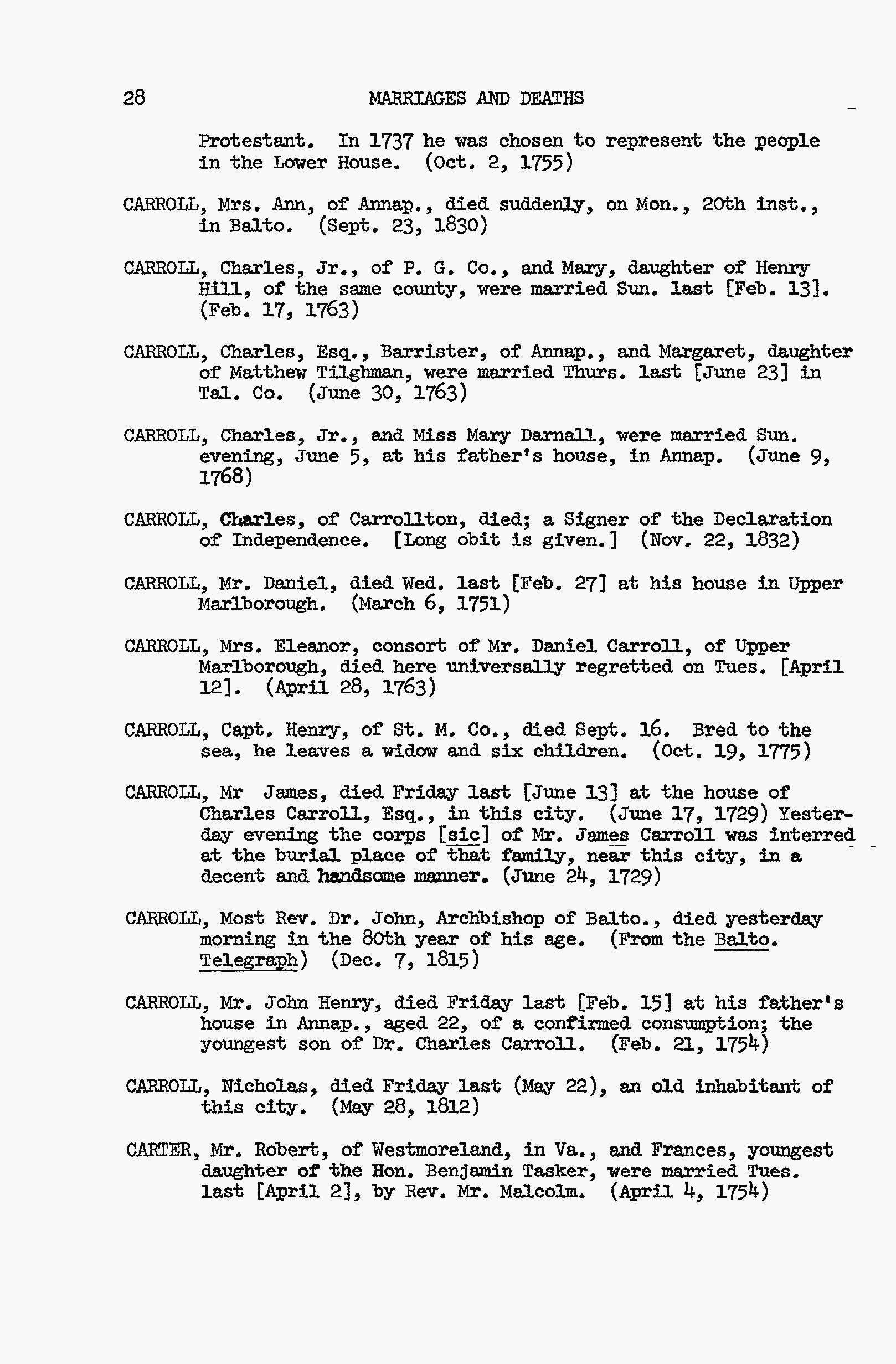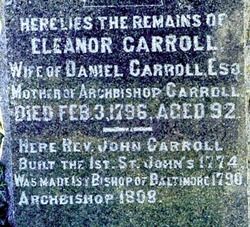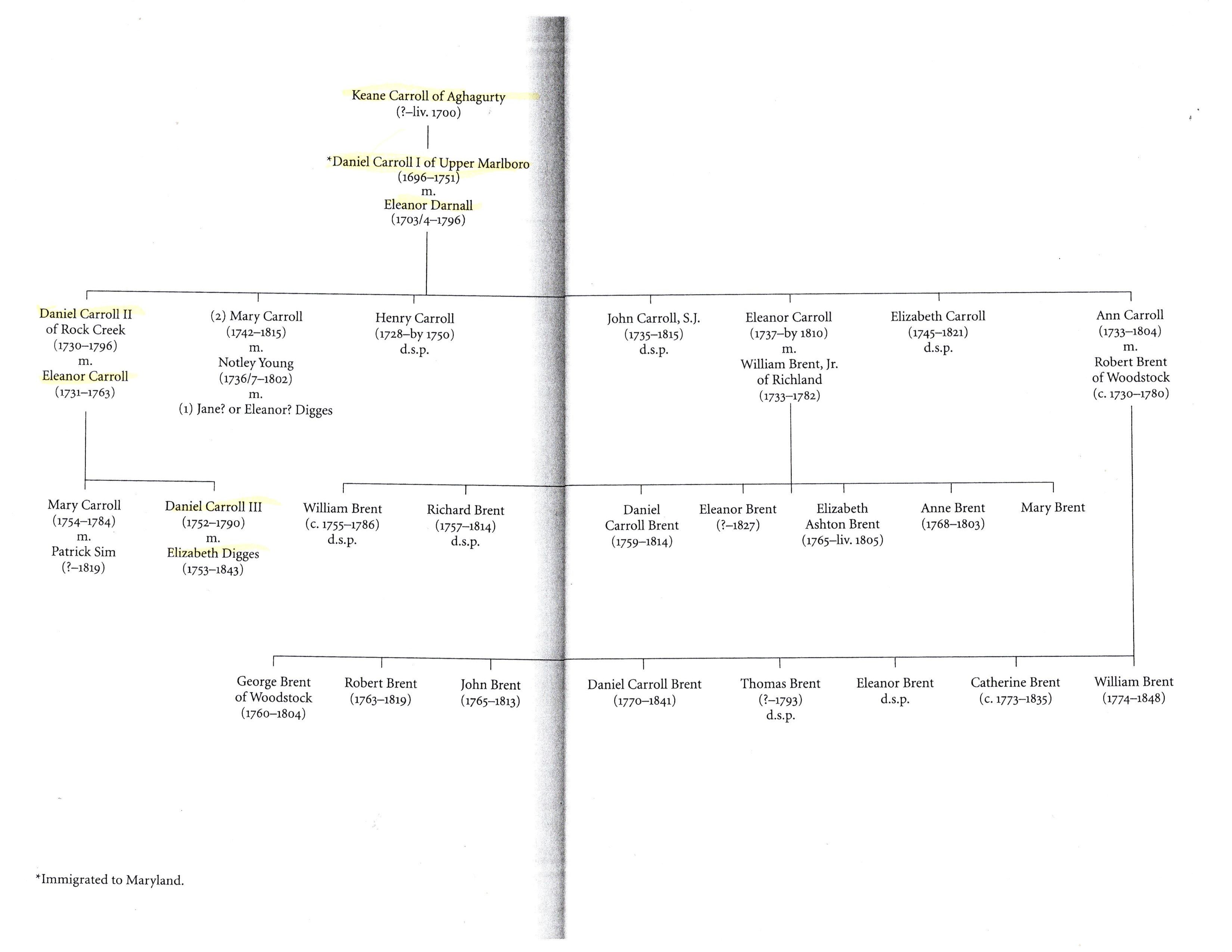He is the son of Keane Carroll of Aghagurty living 1700 and grandson of Daniel Caroll of Ballymooney d bef 1661 Ireland. See these books for more details about this branch of the Carroll family:
Daniel Carroll II One Man and His Descendants by M. Virginia Carroll.
Princes of Ireland, Planters of Maryland A Carroll Sage 1500-1782 by Ronald Hoffman.
From Wikitree,
Daniel was born in 1696 in Ireland, the son of Keane Carroll. Keane was probably born after 1620 and before 1660, possibly around 1655. He is believed to have been a son of the second marriage of Daniel Carroll of Ballymooney. His father was outlawed as a result of his participation in the Confederate wars, and exiled to Spain. He was attained for treason and his property confiscated. Keane is believed to have married Mary Dillon and is thought to have had 4 children. Keane obtained a lease for the property 'Aghagurty' from his relative Richard Grace, in 1686 and became known as Keane Carroll 'of Aghagurty', which means 'Fields of Hunger'. His half brother Daniel was made head tenant on another portion of land and was known as Daniel Carroll of Aghagurty. There was widespread famine as a result of the confiscation of property from the Irish who rebelled against the English plantations and Catholic oppression.
Keane served as a Jacobite soldier under Brigadier Francis Carroll in the Williamite wars and survived the Battle of Boyne in July 1690 when the Jacobites were defeated. He was attainted for treason in 1691 and his property was forfeited. Many of his kinsmen and thousands of his fellow Jacobites went into exile in France. In 1694 he filed for restoration of his lease under the Limerick Agreement and this was granted. However, in 1700, the trustees of the forfeited properties refused to uphold the decision, even though Keane had already paid a significant sum to settle it. In 1703 the property was sold to an English company, the Corporation of Hollow word Blades. Keane and his wife both died before 1706, according to the details of her father's will.
In 1717, when he was 21 years old, Daniel emigrated to Maryland after the trustees of forfeited estates had refused to reinstate his father's land at Aghagurty. Daniel married Eleanor Darnall, in 1727. She was a distant cousin by marriage, whose grandfather Henry Darnall was from England and they had 7 children. On his arrival in Maryland he was helped by his father's cousin Charles the Settler, (1661-1720) who was the progenitor of the prominent political Carroll family of Maryland. Charles Carroll the Settler was governor general of the Maryland colony and his grandson Charles Carroll of Carrollton was the only Catholic signatory to the Declaration of Independence.
The Carrolls have their origins in the ancient kingdom of Éile in the midlands of Ireland. They were a branch of the original O'Cearbhaill clan of Éile, (anglicised as O'Carroll of Ely) which was broken up by the English in the late 16th century. The clan lands and castles were surrendered to the English crown, they were induced to drop the O' from their name and were re-settled according to the policies of the time. Much of the re-settled land was later confiscated after a number of Carrolls were outlawed or tried for treason after fighting against the English parliament in the Confederate Wars and on the side of the deposed King James II against the Protestant crown. A number of Carrolls emigrated to Cheasapeake as a result of their land being seized.
Daniel became a merchant known as Daniel Carroll I of Upper Marlboro. His wife inherited the property known as Darnall's Chance from her grandfather Henry Darnall and they raised their family here. Today, there is a museum at the site, Darnall's Chance House Museum, an historic house museum listed on the national Register of Historic Places in the U.S. It opened to the public in 1988.
In 1741, the Carrolls sold six and three quarter acres of their land to James Wardrop, a merchant from Scotland. He built a 15-room house which still stands on the property. In the mid 1800's a second floor was added to the house and it was remodelled in an Italian/Greek revival style. In 1974, the house was acquired by the Maryland-National Capital Park and Planning Commission for use as administrative offices. It was later renovated again and turned into an historical house museum at which time it was renamed Darnall's Chance, after its first owner, Henry Darnall, grandfather of Eleanor (Darnall) Carroll. It was listed on on the National Register of Historic Places in 1978. In 1986, the second floor and roof were removed, and the house restored to its original 18th century appearance. It opened as Darnall's Chance House Museum in 1988. The focus of the tour of the house offered by Maryland-National Capital Park and Planning Commission, is the lives of the women who lived there over the course of the house's history.
Daniel is known for having sold his land to lay out the town of Baltimore in 1729. He is also known for his son, Daniel Carroll II, (July 22, 1730 – July 5, 1796) who became a politician and one of the Founding Fathers of the United States. Daniel Carroll was a signatory to both the Articles of Confederation and the Constitution of the United States. Another of Daniel's sons, became Archbishop John Carroll, the first Catholic bishop in the United States and founder of Georgetown University.
The Carroll family are famed for the number of beautiful homes and manors they have built across Maryland. Most famous is Doughoregan Manor, in manor Lane near Ellicott City, Maryland (which was built by Charles Carroll the Settler on his slave plantation). This property is listed as a a U.S. Historical Places Landmark but remains in the possession of descendants of Charles Carroll of Carrollton, who is buried there. However, negotiations have been underway to re-zone part of it for development and for the Historical Trust to purchase a part of the property to be developed as a park.
Another early residence of this branch of the family was the Carroll House of Annapolis. The later Homewood House was the birthplace of Governor John Lee Carroll another distant cousin of Daniel Carroll of Upper Marlboro and is now a part of Johns Hopkins University.
Daniel Carroll I died in Maryland on 27th February 1751.
OBIT: CARROLL, Mr. Daniel, died Wed, last (Feb, 27) at his house in Upper Marborough, (March 6., 1751)
He is the son of Keane Carroll of Aghagurty living 1700 and grandson of Daniel Caroll of Ballymooney d bef 1661 Ireland. See these books for more details about this branch of the Carroll family:
Daniel Carroll II One Man and His Descendants by M. Virginia Carroll.
Princes of Ireland, Planters of Maryland A Carroll Sage 1500-1782 by Ronald Hoffman.
From Wikitree,
Daniel was born in 1696 in Ireland, the son of Keane Carroll. Keane was probably born after 1620 and before 1660, possibly around 1655. He is believed to have been a son of the second marriage of Daniel Carroll of Ballymooney. His father was outlawed as a result of his participation in the Confederate wars, and exiled to Spain. He was attained for treason and his property confiscated. Keane is believed to have married Mary Dillon and is thought to have had 4 children. Keane obtained a lease for the property 'Aghagurty' from his relative Richard Grace, in 1686 and became known as Keane Carroll 'of Aghagurty', which means 'Fields of Hunger'. His half brother Daniel was made head tenant on another portion of land and was known as Daniel Carroll of Aghagurty. There was widespread famine as a result of the confiscation of property from the Irish who rebelled against the English plantations and Catholic oppression.
Keane served as a Jacobite soldier under Brigadier Francis Carroll in the Williamite wars and survived the Battle of Boyne in July 1690 when the Jacobites were defeated. He was attainted for treason in 1691 and his property was forfeited. Many of his kinsmen and thousands of his fellow Jacobites went into exile in France. In 1694 he filed for restoration of his lease under the Limerick Agreement and this was granted. However, in 1700, the trustees of the forfeited properties refused to uphold the decision, even though Keane had already paid a significant sum to settle it. In 1703 the property was sold to an English company, the Corporation of Hollow word Blades. Keane and his wife both died before 1706, according to the details of her father's will.
In 1717, when he was 21 years old, Daniel emigrated to Maryland after the trustees of forfeited estates had refused to reinstate his father's land at Aghagurty. Daniel married Eleanor Darnall, in 1727. She was a distant cousin by marriage, whose grandfather Henry Darnall was from England and they had 7 children. On his arrival in Maryland he was helped by his father's cousin Charles the Settler, (1661-1720) who was the progenitor of the prominent political Carroll family of Maryland. Charles Carroll the Settler was governor general of the Maryland colony and his grandson Charles Carroll of Carrollton was the only Catholic signatory to the Declaration of Independence.
The Carrolls have their origins in the ancient kingdom of Éile in the midlands of Ireland. They were a branch of the original O'Cearbhaill clan of Éile, (anglicised as O'Carroll of Ely) which was broken up by the English in the late 16th century. The clan lands and castles were surrendered to the English crown, they were induced to drop the O' from their name and were re-settled according to the policies of the time. Much of the re-settled land was later confiscated after a number of Carrolls were outlawed or tried for treason after fighting against the English parliament in the Confederate Wars and on the side of the deposed King James II against the Protestant crown. A number of Carrolls emigrated to Cheasapeake as a result of their land being seized.
Daniel became a merchant known as Daniel Carroll I of Upper Marlboro. His wife inherited the property known as Darnall's Chance from her grandfather Henry Darnall and they raised their family here. Today, there is a museum at the site, Darnall's Chance House Museum, an historic house museum listed on the national Register of Historic Places in the U.S. It opened to the public in 1988.
In 1741, the Carrolls sold six and three quarter acres of their land to James Wardrop, a merchant from Scotland. He built a 15-room house which still stands on the property. In the mid 1800's a second floor was added to the house and it was remodelled in an Italian/Greek revival style. In 1974, the house was acquired by the Maryland-National Capital Park and Planning Commission for use as administrative offices. It was later renovated again and turned into an historical house museum at which time it was renamed Darnall's Chance, after its first owner, Henry Darnall, grandfather of Eleanor (Darnall) Carroll. It was listed on on the National Register of Historic Places in 1978. In 1986, the second floor and roof were removed, and the house restored to its original 18th century appearance. It opened as Darnall's Chance House Museum in 1988. The focus of the tour of the house offered by Maryland-National Capital Park and Planning Commission, is the lives of the women who lived there over the course of the house's history.
Daniel is known for having sold his land to lay out the town of Baltimore in 1729. He is also known for his son, Daniel Carroll II, (July 22, 1730 – July 5, 1796) who became a politician and one of the Founding Fathers of the United States. Daniel Carroll was a signatory to both the Articles of Confederation and the Constitution of the United States. Another of Daniel's sons, became Archbishop John Carroll, the first Catholic bishop in the United States and founder of Georgetown University.
The Carroll family are famed for the number of beautiful homes and manors they have built across Maryland. Most famous is Doughoregan Manor, in manor Lane near Ellicott City, Maryland (which was built by Charles Carroll the Settler on his slave plantation). This property is listed as a a U.S. Historical Places Landmark but remains in the possession of descendants of Charles Carroll of Carrollton, who is buried there. However, negotiations have been underway to re-zone part of it for development and for the Historical Trust to purchase a part of the property to be developed as a park.
Another early residence of this branch of the family was the Carroll House of Annapolis. The later Homewood House was the birthplace of Governor John Lee Carroll another distant cousin of Daniel Carroll of Upper Marlboro and is now a part of Johns Hopkins University.
Daniel Carroll I died in Maryland on 27th February 1751.
OBIT: CARROLL, Mr. Daniel, died Wed, last (Feb, 27) at his house in Upper Marborough, (March 6., 1751)
Family Members
Advertisement
Advertisement











